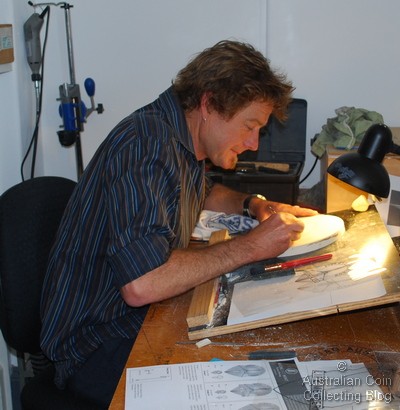The blog team recently met with designer, engraver and sculptor Tony Dean at his Medal Art Mint facility in the picturesque Bega Valley 400km south of Sydney. Tony Dean is probably best known by collectors of the Coloured Ocean Series of one dollar coins released by the Royal Australian Mint in 2006-2007 and those who possess the $1 and 20c Lifesaver coins released in 2007.
It was at the age of 17 that Tony started as an apprentice to Czech born engraver Emil Hafner in Melbourne where he learnt the basics and techniques to guide him through all facets of creating coins, medals, pins and tokens. With an eye for creativity and graphic design he has been employed by both the Perth Mint and The Royal Australian Mint in Canberra. Stints at both these mints saw Tony design popular coins such as the 1991 State Series Tasmanian $10 coin from the RAM (as Tony Dean-Kellock) and the 1995 Silver Kookaburra specimen issues from the Perth Mint.
A more recent achievement was an invitation to join the RAM team while one of the chief designers was on long service leave in 2006. He was given the task of designing a circulation dollar coin to promote the Year of the Surf Lifesaver. The mint later changed their decision to release this coin into circulation but it made a superb addition to the 2007 year set struck only in proof quality. Tony also designed the Lifesaver 20c issued in the mint set and Australia Post pnc.
During his time at the RAM in 2006 he also created the designs for the Coloured Ocean series of dollars released by the RAM. These pad-printed designs popular with young collectors have a minimal amount of design struck onto the coin and proved a relatively simple graphic design task. An NCLT Commonwealth Games dollar was also issued during this period that was sculpted by Tony.

Tony at work on a design for a Rowing Australia Pin
More recently Tony has chosen a lifestyle change and decided to open a design studio and office called Medal Art Mint on the far south coast of New South Wales. Here he designs and sculpts plaster, plasticine, silicone rubber and epoxy resin model designs to be made into medals, tokens, medallions and plaques. These models are then taken to the workshop facilities to be turned into hobs and dies to then strike the product for the client. Tony has designed commemorative and prize medals, pins and medallions for the CSIRO, the Australian Academy of the Humanities, Rowing Australia and the Singapore Womens Cycling Team just to name a few. These designs vary from the most intricate of pieces to basic geometric shapes.
Medal Art Mint oversees the entire production process. Firstly discussing with the client their ideas, their needs, size, metal type, delivering concept drawings and modelling the medal design in plaster. The plaster is then cast in silicone and the silicone cast into hard epoxy resin which is taken to the workshop to make a master die to then be used to strike the medal. This process in detail can be found in the article: Coin Designers - Tony Dean Part 2. This process can be done for an order of just one unique medal or a production run of a million!
The whole process of hand sculpting and engraving detailed artistic pieces in plaster and metals is a fine art. Add to this the technological processes of the new century. Medal Art Mint and key designer Tony Dean uses traditional skills learnt from a master engraver combined with the latest computer technology to manufacture the most magnificent struck pieces for any special occasion.
Posted by harrisk at November 22, 2009 7:36 AM
Subscribe to our Newsletter


